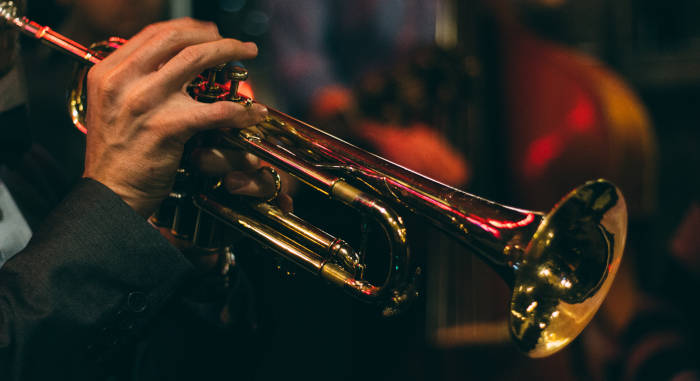
The trumpet appears in a wide variety of musical ensembles, ranging from classical orchestras and jazz groups, to pop, rock and salsa bands.
And whether you’re practicing at home or performing on stage in front of thousands, the proper way to hold the trumpet remains the same. Each of your fingers has its purpose.
Here we’ll cover the best practices for holding your instrument with emphasis on maximizing comfort. Proper technique will not only benefit you in helping you toward becoming a better musician. It will also benefit any future audience that listens to you perform.
Securing your mouthpiece
The first task to holding your trumpet is to gently insert the mouthpiece into the receiver so it’s securely seated and won’t fall out.
Avoid twisting the mouthpiece hard or otherwise forcing it into the receiver. Often the mouthpiece gets stuck and requires a special tool to remove it. If this happens, don’t try to remove the mouthpiece yourself, as doing so could damage your instrument.
Most band directors and local music shops have the necessary tool to remove a stuck mouthpiece.
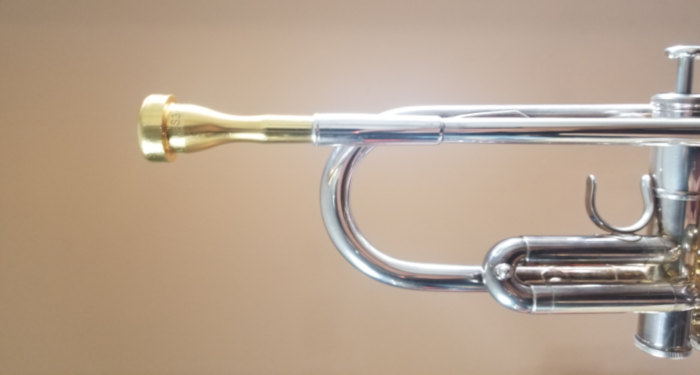
Positioning your left hand
Regardless of which is your dominant hand, your left hand will serve to operate the first and third valve slides and grip the trumpet. Start by grabbing the trumpet with your left hand so the mouthpiece is facing toward you and the bell is facing away from you at an angle toward the floor.
Thumb in the first valve ring
Your trumpet should have a finger ring or u-shaped hook attached to the first valve slide (the slide running toward the mouthpiece). Insert your thumb into this first valve ring. You’ll use your thumb on this ring to extend and retract the slide when using the first value.
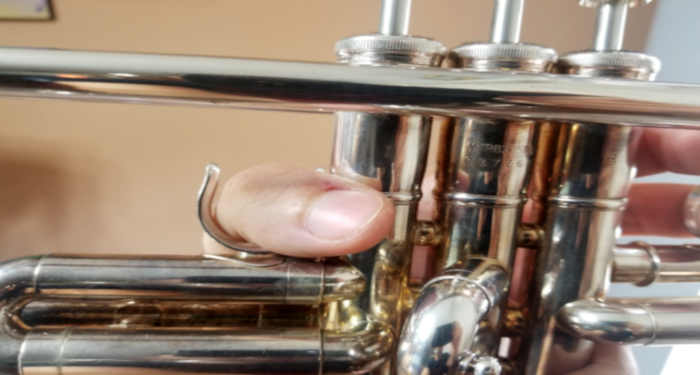
Middle or ring finger in the third valve ring
On the third valve slide (the longest one branching off from the third valve casing and running toward the bell), you’ll find the third valve ring. This ring is fixed permanently in place on some trumpets while adjustable for comfort on others.
Place either your ring finger or middle finger in this ring, whichever is most comfortable.
Some players with relatively small hands often prefer to use their ring finger. While those with larger hands may feel more comfortable using their middle finger. Preference can also change, especially for younger players whose hands will grow larger.
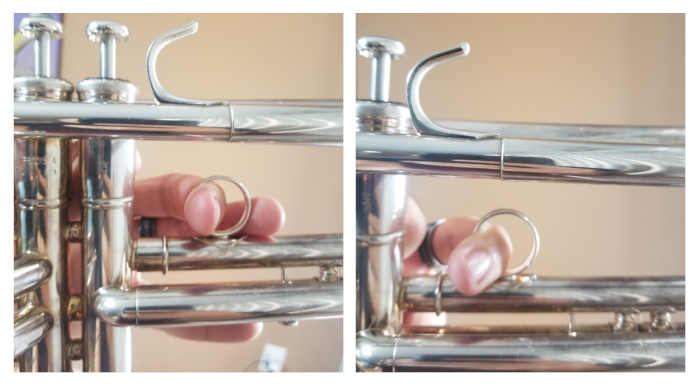
Gripping the trumpet with remaining fingers
With your left thumb and either middle or ring finger in place, wrap your remaining fingers around the third valve casing at the far end of the trumpet.
Depending on which finger you’ve put in the third valve ring, you’ll probably want one or two fingers above and below the third valve slide.
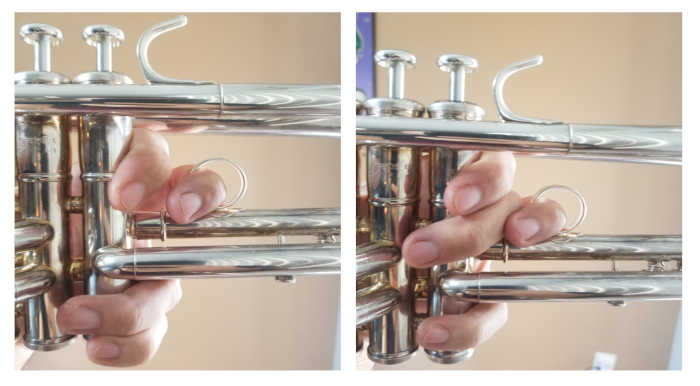
Positioning your right hand
The right hand is responsible for most of the movement on the trumpet. Whereas the fingers on your left hand move the slides, the fingers on your right will depress the valves.
Holding the trumpet in the right hand tends to feel slightly more intuitive and less awkward than holding it in the left.
Three fingers on the valve keys
Place your index finger on the first valve key (closest to you), your middle finger on the middle valve key and your ring finger on the third valve key (farthest from you).
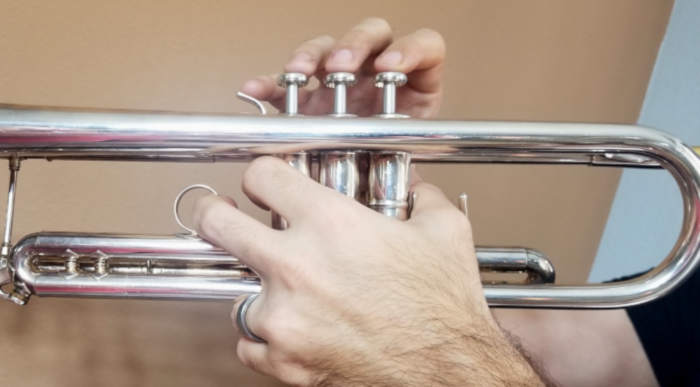
Resting the pinky finger
You should see a c-shaped hook welded to the top of the leadpipe just past the third valve. This is called the pinky ring, or finger hook.
Either rest your right pinky finger on top of this hook or hold it freely above the trumpet. Keeping this finger in either position will ensure your remaining fingers have easy range of motion for better performance.
The only time you generally want to have your pinky inserted in the hook is when you need to turn pages of music with your left hand while playing. I don’t suggest keeping your pinky in the hook when not necessary. This can slow down the speed of your fingers working the valves.
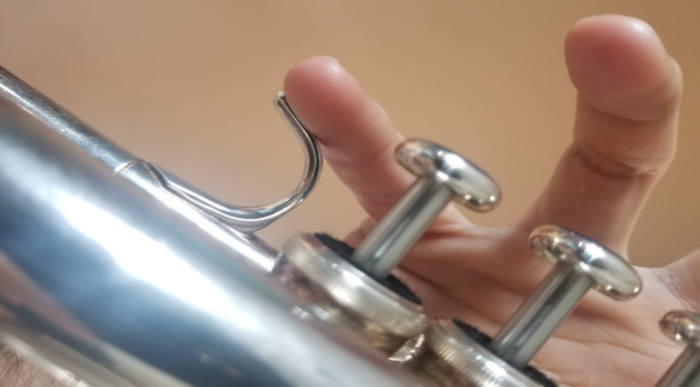
Holding your thumb under the leadpipe
Hold your thumb in a comfortable place somewhere under the leadpipe between the mouthpiece and the first valve. The exact thumb placement can vary between trumpeters based on thumb shape. Just be sure yours isn’t inhibiting your index, middle and ring fingers.
Holding your trumpet with proper posture
Not every trumpet performance occurs seated. Standing while playing is an integral part of marching band, for example, and is a normal experience for most trumpeters playing in high school or college bands.
Maintaining good posture is an important part of properly holding and playing the trumpet, whether you’re standing or seated.
Playing trumpet seated
If seated while playing, such as in a wind ensemble or orchestra, it’s best to sit up. Either keep your back straight or rest it comfortably against the back of your chair. This will help you breathe effectively and will make playing easier in general.
Playing trumpet standing
If standing while playing, avoid slouching or letting your head slump forward. Just as with sitting, staying upright will allow you to breathe easier and prevent unnecessary tension in the body.
Keep your feet planted firmly on the ground in a way that avoids discomfort. And keep both hands on the instrument whenever the mouthpiece is resting on your mouth.
The bell of the trumpet should be pointed comfortably forward, in order to avoid strain and project sound forward toward the audience.
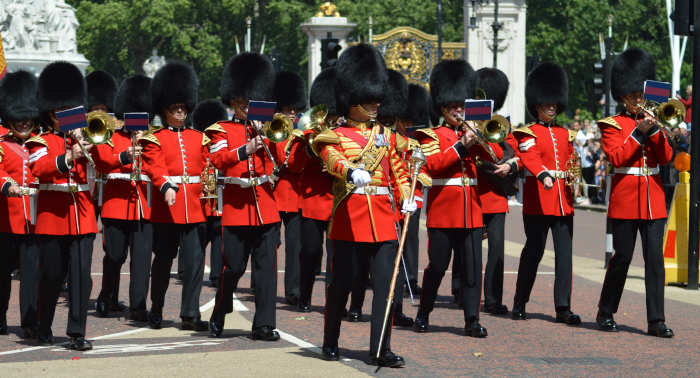
Common trumpet holding mistakes
It’s natural to make some mistakes as you make progress with the trumpet. But mistakes can cause problems when musicians form bad habits from them. Here are a few common mistakes to avoid when handling your trumpet:
Playing through pain in the hands
Comfort is essential for enduring through longer playing sessions. If your hand position causes any wrist or finger pain, see if you can move your hands slightly to alleviate the pain.
Bumping into things
It’s never a pleasant experience to have your mouthpiece abruptly collide with or pinch your lips. Such incidents can cause swelling, and in severe cases, breaking a tooth. Be careful to avoid bumping your instrument into anything, especially when you’re holding it to or near your face.
Resting the trumpet on a knee or chair
Resting the bell of the trumpet on your knee or anything else during playing will diminish the volume and quality of sound from the instrument. Doing so also gives the impression that the musician isn’t very interested in what they’re doing. For these reasons, most band directors discourage this behavior.
Conclusion
With your right hand capable of moving the valves freely and your left hand supporting the trumpet and working the slides, you’re ready to begin playing.
Nobody’s first sound on the instrument is magnificent, so don’t get discouraged. You’re allowing yourself an opportunity to do something very rewarding by playing trumpet. And remembering to do it correctly will keep paying off over a lifetime of being a musician.
Happy music making!
